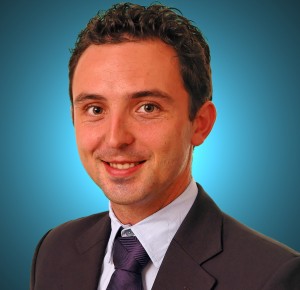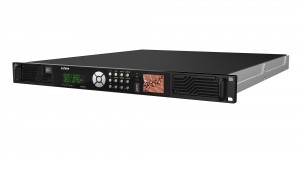SVG Europe Sit-Down: ATEME’s Rémi Beaudouin on VR potential, SuperBowl experience and HDR outlook
ATEME says that it loves video and is always striving for the best video quality. The company also loves technology and has pioneered number of innovations. It is not surprising, therefore, that VP of Marketing Rémi Beaudouin approaches an interview regarding the company’s recent activities with a passion that matches those philosophies.
With VR very much at the forefront of innovation, it was natural to start the conversation with a topic that occupies ATEME’s mind to a considerable degree.
What is your involvement in the VR market – and how do you see this progressing as far as sports broadcasting is concerned?
ATEME is currently involved in VR in two different ways. We’ve partnered with a company called LiveLike for multiple major sporting events, including the SuperBowl, major tennis tournaments, football matches and more. For these types of events, ATEME is taking care of the encoding side, while LiveLike is responsible for the acquisition and playout. We’re also leading a collaborative project funded by the French government called Live 360 TV. The objective of this collaborative project is to develop an end-to-end solution for the live creation, distribution and reproduction of 360° multi-screen audio and video, with a quality that meets broadcast market requirements.
Broadcasters and TV channels are having to try and differentiate themselves from their many competitors, and VR is a great way of doing this. Whether it’s giving the viewer the opportunity to be in the locker room with their favourite team, or sitting next to the coach during a game, it offers an additional experience that viewers are demanding. They want to be able to feel like part of the team and experience the event from the inside. There are still some technical constraints to overcome —resolution, bandwidth, device compatibility, stitching algorithms, and so on — but as technology evolves, the user experience will become more enjoyable and powerful.
In summary, we believe there’s huge traction of VR in sports, and we’re working to be a major part of it. We’ve already participated in lots of proof of concepts and live coverage since 2014, and we’re looking forward to being part of many more throughout 2017 and beyond.
In that regard, can you provide some more details about your recent SuperBowl experience?
 The above workflow diagram gives you an idea of the set-up. The production team was responsible for installing and controlling the wide-angle cameras, while ATEME was in charge of the encoding aspect. This was a specific configuration involving a resolution of 2.5K. We then fed the content delivery network (CDN) with our TITAN Output.
The above workflow diagram gives you an idea of the set-up. The production team was responsible for installing and controlling the wide-angle cameras, while ATEME was in charge of the encoding aspect. This was a specific configuration involving a resolution of 2.5K. We then fed the content delivery network (CDN) with our TITAN Output.
In terms of the VR service itself, this was provided by LiveLike, who built a VIP room which included a player for the video. This VIP room was accessible through Fox Sports’ VR application, available for iOS and Android. During the match, LiveLike were responsible for pushing game highlights and player statistics to the viewers, giving them a more immersive viewing experience.
Can you tell us about the recent collaboration with the wTVision ‘ChannelMaker-in-the-Cloud’ project?
In this specific setup, we encode the live content with our own Kyrion CM5000 encoders and stream it to the Amazon cloud, where wTVision playout operates. The stream is then sent to a channel distribution centre and decoded via the ATEME Kyrion DR5000, where it follows a traditional path towards distribution.
The ATEME cloud philosophy means we can enable our customers to either run their video processing in the cloud, or offer a cloud-based service to their customer. We also allow customers to strike a balance between on-premises, private cloud and public cloud.
ATEME offers three business models depending on the customers’ needs, the first being the perpetual licence model. The second is the rental model, which allows customers to use equipment for a short period of time before handing it back to us. An example of this model would be if a company wanted to use our equipment for one-off transcoding of their VOD library to ABR or HEVC, or provide an additional live channel during a certain event. Then there’s the pay-per-use model, which applies to file-based workflows and enables customers to have the equipment over any time period and simply pay per the amount of transcoding that they do. This could be based on input minutes (via any number of output profiles) or per output GB.
ATEME can offer an additional management and monitoring service on top of any of these above models, either permanently or for a transition period as customers ramp up their own personnel.
Economies are always on the mind of customers. How can ATEME help them achieve savings?
With the ATEME TITAN compression software, operators are now able to use commercial off-the-shelf hardware instead of the dedicated equipment that they employed in the past. This enables further savings on equipment CAPEX by leveraging existing servers as well as blade servers in the data centre, while simplifying the process of ordering and powering up new services. The next step is applying data centre mechanisms such as virtualisation to realise further CAPEX and, more importantly, significant OPEX savings through the use of virtual machines, new redundancy schemes and quick and elastic turn-up of services. It also allows for new business models that are based on private and public cloud architectures and pay-per-use models.
How does handling OTT services differ from traditional broadcasting set-ups, as far as your equipment is concerned?
The main difference between these two set-ups is the number of profiles you have to generate: traditional services only require one – DTT, DTH, cable – while OTT services require multiple in order to address the full range of customers’ devices.
 We expect a growth in OTT consumption again this year. The challenge on the broadcast side will consist in meeting consumer demand without compromising on video quality and having to invest massively in their networks – video may be 4K, that is, at least 15Mb/s per user. In this regard, ATEME offers HEVC codec to reduce bandwidth by 30% to 50% compared to MPEG-4, the previous generation codec, thereby improving image quality and reducing the cost of UHD live broadcasting
We expect a growth in OTT consumption again this year. The challenge on the broadcast side will consist in meeting consumer demand without compromising on video quality and having to invest massively in their networks – video may be 4K, that is, at least 15Mb/s per user. In this regard, ATEME offers HEVC codec to reduce bandwidth by 30% to 50% compared to MPEG-4, the previous generation codec, thereby improving image quality and reducing the cost of UHD live broadcasting
How do you see HDR developing during 2017?
HDR adoption will continue this year, with more and more content production and distribution, such as French tennis Open, Major Football events, Olympics and so on, as well as UHD/HDR capable STB and displays. This will happen alongside the adoption of other technologies that improve the user experience and will further enable its adoption: 4K and Wide Colour Gamut, for instance. Also, BT 2020 colour space, High Dynamic Range, High Frame Rate such as 100/120Hz…
ATEME was the first company to market with production-ready HEVC and HDR. Over the last two years, we’ve worked closely with leading Hollywood studios, TV manufacturers and STB chipset vendors to ensure end-to-end UHD 4K HDR interoperability. ATEME TITAN video transcoding software now supports all the existing HDR distribution technologies, enabling a risk-free deployment of an integrated proven solution. Natively bundling all HDR technologies with ATEME TITAN will allow more operational flexibility and greatly simplify powerful premium HDR workflows.
Finally, do you have any predictions about how sports broadcasting will progress for the next twelve months – and what technologies we should be watching?
VR will continue to be key in this market. Combined with emerging technology – 4K, HDR and HFR for viewing experience and HEVC codec to reduce bandwidth – this will transform the viewer experience into something much more immersive, and will enable its adoption.


